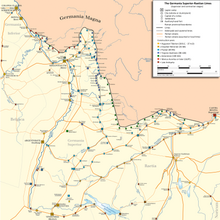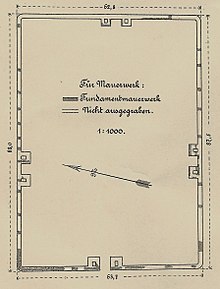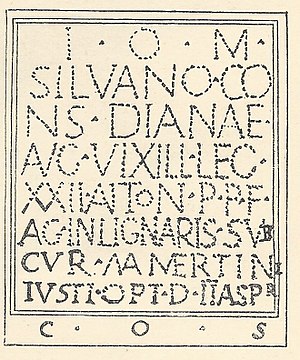Castle Trennfurt – Wikipedia
| Kastell Trennfurt | |
|---|---|
| Limes | ORL 37 (RLK) |
| Route (RLK) | Obergermanischer Limes, route 6 (main line) |
| Dating (occupancy) | Probably in the middle of the 2nd year, Votive stone from 212 AD |
| Type | Numeruskastell |
| Size | 88 m × 63 m (= 0.6 ha) |
| Construction | Stone fort, previously probably wood-earth-forel |
| Conservation state | Only weak floor traces, not built over |
| Location | Klingenberg am Main- Trennfurt |
| Geographical location | 49 ° 46 ′ 40.4 ″ N , 9 ° 10 ′ 40.9 ″ O |
| Height | 127 m ü. Nhn |
| Previous | Kastell Wörth (Orl 36) |
| Afterward | Kastell Miltenberg-Altstadt (Orl 38) |
The Kastell Trennfurt was a Roman numerus castle in Trennfurt, today a district of Klingenberg am Main, in the Miltenberg district in Lower Franconia. It belongs to the Mainlime Castle Chain, was in the Roman province of Germania Superior and is part of the UNESCO World Heritage Site Obergermanisch-Raetic Limes (Orl). According to the count of the Reichs Limes Commission (RLK), it bears the name Orl 37. The castle is listed and is entered in the Bavarian list of monuments under D-6-6221-0050. Nothing of the facility can be seen above ground today.




The former castle is located northeast of the old town center of Trennfurt between what is only about 160 meters away today’s regulated and dammed Main in the east and the old Roman road Seligenstadt – Miltenberg in the west, which is about 200 meters away, in the west Separator street (former B469) in the west and the Miltenberg-Achaffenburg railway line east of the Kastell.
The majority of the castle today consists of meadows and garden land. The majority is private site and is not freely accessible. A small part of the northeastern corner of the former fort has been under the railway embankment since the 1870s. [first] In the north it is made by the buildings on the south side of the Bahnhofstrasse limited, which flows into the separate road, to the south to from an unnamed path at the level of the Trenfurter Straße 51 in the direction of the free slip of today’s outdoor pool. The fort is located on the western side of the railway embankment against today’s outdoor pool. On the east side of the railway embankment there was an old arm of the Main, and the fort is also classified as a port. [2]
In Roman times, a road connection to the older Odenwaldlimes on the Kastell Hainhaus near Vielbrunn is assumed, which is said to have passed as a forest path until modern times and until the excavations of the Reich Limes Commission. [2] A connection to the Earthwerk Ohrbacher Schanze in connection with wood fell work for the Mainz region was also suspected and already postulated by Conrady and the “Agens in Lignariis” Vexillations of the Legio XXII Primigenia Piae Fidelis stationed in Mainz, which are assigned through inscriptions from 206 to 214 are dated along the mainlime. [2]
After the discovery of a Roman consecration and Roman coins, of which Christian Ernst Hanßelmann learned in 1771 and reported in 1773, it was assumed that there was a Roman military camp in Trennfurt. Wilhelm Conrady, the later route commissioner of the Reich Lime Commission, then discovered the fort in excavations, which he carried out in 1883 before the Reichslimeskommission was founded. He published the result in 1900 in the excavation reports of the Reichs Limes Commission, which himself no longer made his own excavations. [3] Even later no excavations took place on the castle. According to Conrady, the surprisingly rectangular fort is about 88 meters long (south -southwest to east northeast) and 63 meters wide (north northwest to south -southeast) and occupies an area of a little less than 0.6 hectares. Only the surrounding walls were excavated. The Praetorialfront in the east could not be excavated because it was affected by the railway embankment. This corresponds to the normal size of a numerus castle, but with its strongly rectangular shape deviates from the castle shape in the Odenwald and on the Main. [4] The fort was surrounded by just one pointed ditch, the simple execution of which Conrady was able to prove on the south flank of the fort. Conrady continues to indicate several finds in his excavation report: such an amphora fragment, several Terra-Siga-Sigerben, a Father, a wrinkle cup, bowl residue in bowl shape, a roof brick fragment and the iron nails that are usually found frequently. None of the finds described is still available today. The Roman coin finds described in 1773 can also no longer be found. [5]
When the fort was built and how long it was used is unknown. Its usage can only be dated in the middle of the 2nd to the middle of the 3rd century AD. It was part of the younger Limes (younger Mainlimes), which was predated to the Main around 150 AD, which then steadily runs south after the second Miltenberg Kastell Miltenberg-Ost. Although only a sparse development was carried out (two houses in the northeast and northwest) except for the eastern castle front (railway), the castle area is no longer visible superficially. This is certainly due to the proximity of the Alte Trennfurt, which contributed to the fact that all stone material was used for the location [first] , as happened, for example at the Lützelbach Kastell, until the beginning of the 20th century.
However, one time has been handed down on the Roman consecration, which was already in 1751 [6] was found in Trennfurt and which is now walled in the interior of the parish church of St. Maria Magdalena. The consecration stone was originally unprotected at the school building next to the church. The inscription almost couldn’t be read. In 1834 he was walled in in the cemetery, weathered and vermooste. In 1881 Karl Zangemeister examined the stone again and excited the term timberary . This name for woodworkers had already been detected in Stockstadt and also in Obernburg. Conrady examined the stone in 1899 and deciphered the heavily weathered inscription as follows: ” I(ovi) o(ptimo) m(aximo), Silvano cons(ervatori) Dianae Aug(ustae) vixill(atio) leg(ionis) XXII Anton (initianae) p(rimigeniae) p(iae) f(idelis) ag( Being) in a wooden (1) S below Why (a) Mamertini Just Opt (IO) D (Edicavit) (ARE) CO (N) S (N)) “. [7] According to today’s knowledge, his reading is not entirely correct, but this does not change the content. After that, the stone was dedicated to the gods Jupiter, Silvanus and Diana a year when the two Asper consuls were devoted to the gods of the 22nd Legion. The two Asper, Gaius Iulius Asper and his son Gaius Iulius Camilius Asper, are certified as a consuln in 212 AD. [8] The reconstructed original text was put into the stone shortly after 1900 – a procedure that would be irresponsible from today’s perspective. [9]
Another Neptune dedicated consecration, has also been lost today. [first] [ten]
| transcription | in capitaln | Picture |
|---|---|---|
I (these) O (Pimte) M (aximo) |
I O M |
|
Whether the one specified on the consecration stone Legion 22 primary The crew of the fort or was temporarily only in the fort for the assumed wood procurement for Mogontiacum was also clear.
Conrady already assumed that the wood was transported for the Roman troops on the Main, especially since the fort was only around 40 meters from the old river arm of the Main, which was used for loading with ships and rafts. This arm, which separated an area east of it with the field name “The Island”, was already overwhelmed at the time of Conrady, but was still recognized in the area, which has no longer is. [11]
An associated Vicus and a development within the fort have not yet been demonstrated, since Conrady only grubs the border of the fort. Under Conrady, the Vicus was suspected on flood -free areas west of the fort. [twelfth] Streunda south of the fort now allow the acceptance of a Vicus there. [13] This and the unusual proximity to the neighboring castell Wörth led to the assumption that the fort was not occupied all year round and were only used during the woodwork mentioned. On the other hand, it speaks that the location of the Trenfurt Castell is better in the regular sequence of the Mainlime castle than Wörth, which in this regard could rather be assigned to the Odenwaldlimes. In addition, Conrady had to concentrate on the surrounding walls and gates during his excavation cuts. The question remains unclear as long as no new investigations are carried out on site. [14]
Probably in the realm of imagination the legend can be seen that the place has its name from Emperor Trajan, who has moved with his army here over a ford east of the Main ( Trani shallow ) and as modified Trajansfurt in Trennfurt should have changed. [15]
The Kastell Trennfurt is under the inventory number D-6-6221-0050 Castel of the Roman Empire Bod monument according to the Bavarian Monument Protection Act (BaydschG). [16] Research and targeted collecting of finds are subject to approval to report random finds immediately to the lower monument protection authorities or the Bavarian State Office for the Preservation of Monuments.
- Dietwulf Baatz: The Roman Limes. Archaeological excursions between the Rhine and the Danube. 4th edition. Gebr. Mann, Berlin 2000, ISBN 3-7861-2347-0, p. 215.
- Dietwulf Baatz, Fritz-Rudolf Herrmann: The Romans in Hesse. License edition, Nikol, Hamburg 2002, ISBN 3-933203-58-9. (P. 482 f. In the edition of 1982)
- Bernhard Beckmann: The Roman Limes Castle Trenfurt . In: Chronicle of the city of Klingenberg am Main. Part 1. Klingenberg 1994, p. 33–42 ( Digitized of the city of Klingenberg (PDF file, 46.9 MB))
- August von CoHausen: The Roman border in Germany: military and technical description of the same , 1884, S. 16
- Wolfgang clean u. A. The Romans in Bavaria. License edition, Nikol, Hamburg 2005, ISBN 3-937872-11-6.
- Britta Rabold, Egon Schallmayer, Andreas Thiel: The limes. The German Lome Road from the Rhine to the Danube. TheSes publisher, 2002, Pl 69 f.
- Hans Schönberger: The Roman troops of the early and medium imperial period between the North Sea and Inn. In: Report of the Roman-Germanic Commission. 66, 1985, S. 478.
- C. S. Summer: Kastellvicus and Kastell. In: Fund reports from Baden-Württemberg. Volume 13, 1988, pp. 457–707 (in it to Trennfurt p. 695)
- Bernd Steidl, Ludwig Wamser, Horst Zimmerhackl: Limes world heritage: Rome’s border on the Main. (= Exhibition catalogs of the Archaeological State Collection. 36). Logo-Verlag Erfurth, Obernburg am Main 2008, ISBN 978-3-939462-06-4, pp. 96-101.
Excavation reports of the Reichs Limes Commission :
- ↑ a b c Bernhard Beckmann: The Roman Limes Castle Trenfurt. S. 36
- ↑ a b c Marcus Nenninger: The Romans and the Forest: Studies on dealing with a natural area using the example of the Roman Northwest provinces. In: Map historical 16. Franz Steiner Verlag, Stuttgart 2001, ISBN 3-515-07398-1, S. 175–181.
- ↑ (Wilhelm Conrady:) The trennfurt castle. Excavated and described by district judge a. D. Conrady. Special print from the works: the Obergerm.- Raet. Limes of the Roemer Empire. Published on the behalf of the Reichs Limes Commission by O (Scar). by Sarwey, E (Rnst). Fabricius, f (Elix). Hettner. Verlag Otto Petters, Heidelberg 1900, pp. 1–3.
- ↑ (Wilhelm Conrady:) The Kastell Trennfurt , Heidelberg 1900, S. 3–8.
- ↑ Bernhard Beckmann: The Roman Limes Castle Trenfurt. P. 42, there note 7
- ↑ Bernhard Beckmann: The Roman Limes Castle Trenfurt. S. 37
- ↑ W. Conrady: The trennfurt castle. 1900, S. 13.
- ↑ Bernhard Beckmann: The Roman Limes Castle Trenfurt. P. 40; also: CIL XIII, 6618
- ↑ Marion Mattern: Roman stone monuments from Hesse south of the Main and the Bavarian part of the Mainlime. Publisher of the Roman-Germanic Central Museum, 2005, p. 128 f.
- ↑ W. Conrady: The Kastell Trennfurt . 1900, pp. 1 and 9 ff.
- ↑ W. Conrady: The trennfurt castle. 1900, S. 7.
- ↑ Kastell Trennfurt. on the side of the German Limes Commission; accessed on March 27, 2018.
- ↑ Kastell Trennfurt on Museums on the Mainlimes ; accessed on March 27, 2018.
- ↑ Bernhard Beckmann: The Roman Limes Castle Trenfurt. 1994, S. 36–38.
- ↑ J. F. Knapp: Roman monuments of the Odenwald, especially the county of Erbach and rule Breuberg. Darmstadt 1854, S. 138, S. 185.
- ↑ Bavarian list of monuments in Klingenberg am Main

Recent Comments